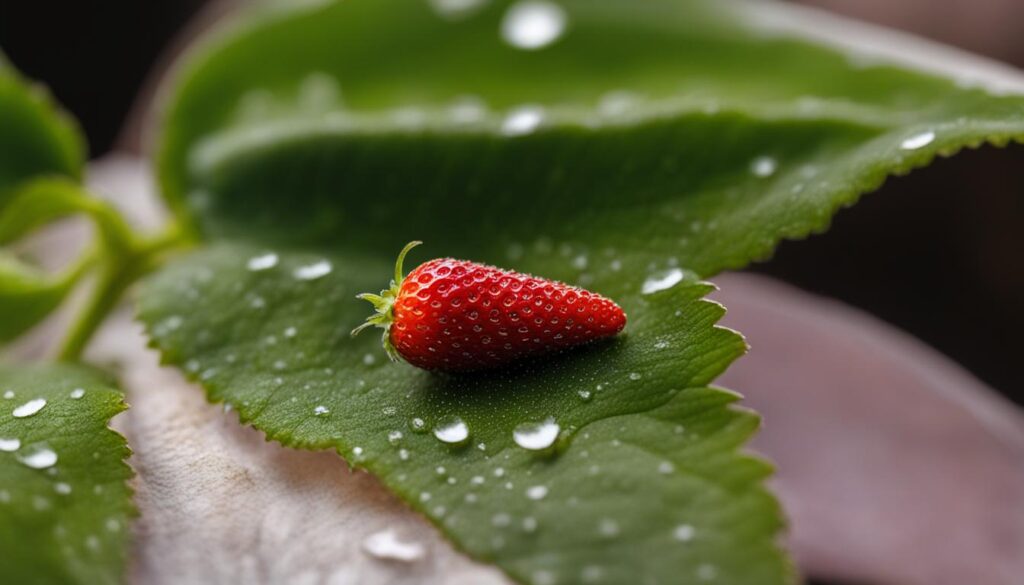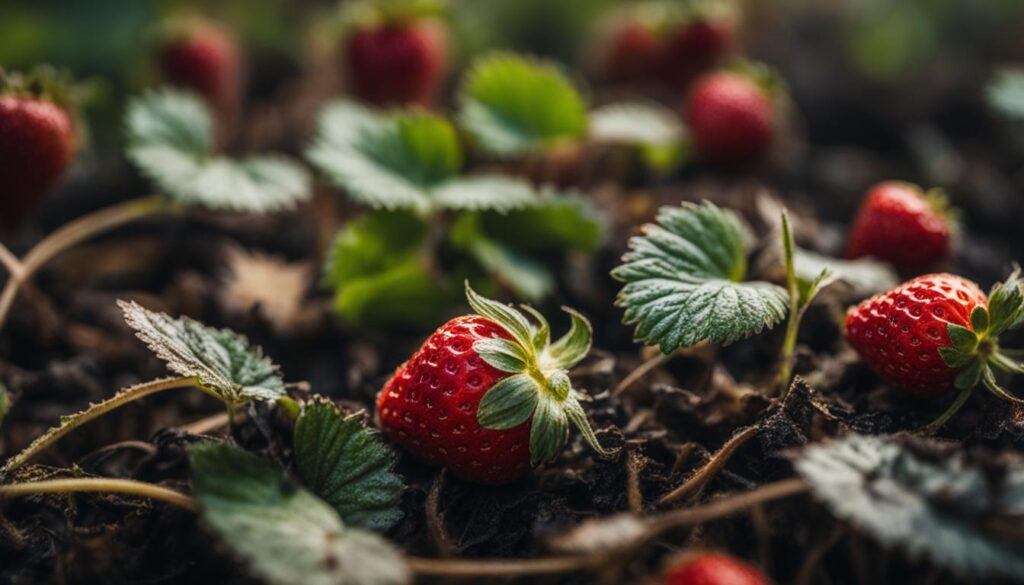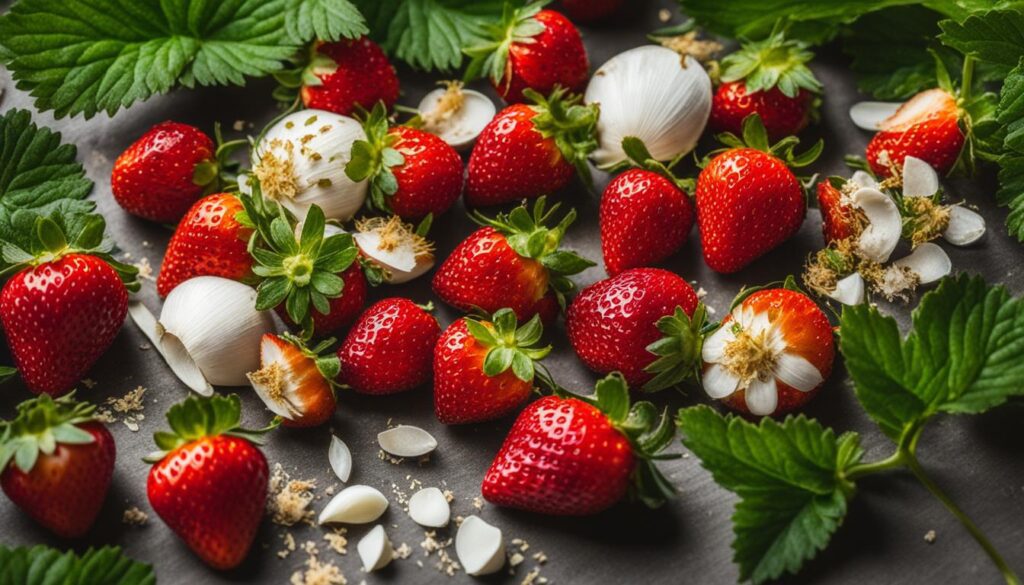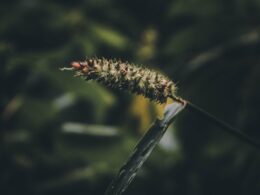If you’re a strawberry enthusiast, you know that pests and diseases can pose significant challenges to the health and productivity of your plants. From bothersome insects to harmful fungal infections, these issues can hinder the growth and yield of your beloved strawberries. But fear not, because in this comprehensive guide, we’ve got you covered with strategies to combat the most common pests and diseases that afflict strawberry plants.
Post Summary
- Strawberry plants are susceptible to various pests and diseases that can affect their growth and yield.
- Factors such as location and weather can influence the prevalence of these issues.
- Opt for disease-resistant strawberry plant varieties and practice proper plant maintenance.
- Natural control methods, such as insecticidal soaps and beneficial insects, can help manage pests.
- Organic strategies, such as removing plant debris and using barriers, can control pests and diseases.
- Identify common diseases like fruit rot, leaf spot, and downy mildew, and use appropriate control methods.
- Prevention is key – practice good sanitation, utilize reflective mulches, and employ natural predators.
Common Strawberry Plant Pests and How to Control Them
Strawberry plants are not immune to various pests that can wreak havoc on their growth and overall health. It is essential to identify these common pests and take proactive measures to control their populations. By employing effective pest control strategies, you can ensure the vitality and productivity of your strawberry plants. Let’s explore some of the most prevalent strawberry plant pests and discuss how to manage them.
Tarnished Plant Bugs
Tarnished plant bugs are small, oval-shaped insects that feed on strawberry buds, flowers, and developing fruits. To control these pests, you can use insecticidal soaps or horticultural oils. They suffocate the bugs without harming the plants. Additionally, attracting beneficial insects such as ladybugs and lacewings can help keep tarnished plant bug populations in check.
Aphids and Spider Mites
Aphids and spider mites are notorious for damaging strawberry plants by sucking sap from leaves and stems. To control these pests, you can employ insecticidal soaps or neem oil. Regularly inspect your plants for signs of infestation and promptly treat affected areas. Furthermore, introducing natural predators like ladybugs can provide long-term control of aphid and spider mite populations.
Slugs and Snails
Slugs and snails are common pests that feast on strawberry leaves, fruits, and stems. To deter these pests, create barriers using diatomaceous earth around the base of your plants. You can also place citrus rinds near your strawberry plants and remove them daily to collect trapped slugs. Remember to keep your garden clean and free of debris, as this minimizes the hiding places for slugs and snails.
| Pest | Damage | Control Methods |
|---|---|---|
| Tarnished Plant Bugs | Damaged buds, flowers, and fruits | Insecticidal soaps, horticultural oils, beneficial insects |
| Aphids and Spider Mites | Leaf and stem damage from sap-sucking | Insecticidal soaps, neem oil, ladybugs |
| Slugs and Snails | Feeding on leaves, fruits, and stems | Diatomaceous earth barriers, citrus rind traps, garden cleanliness |
Effective Methods to Control Strawberry Plant Pests Organically
When it comes to protecting your strawberry plants from pests, organic pest control methods can be an effective and environmentally-friendly option. By using natural remedies and practices, you can minimize the use of harmful chemicals while still ensuring the health and productivity of your strawberry plants.
One of the key organic pest control strategies is to maintain good garden sanitation. Removing plant debris regularly can help eliminate hiding spots for pests and prevent the buildup of infestations. Additionally, deep watering at the base of the plants can help avoid creating excessively moist conditions that attract pests like slugs and spittlebugs.
To create a physical barrier against pests, consider laying down diatomaceous earth around your strawberry plants. This natural substance is made from the fossilized remains of diatoms and acts as a barrier that cuts into the bodies of insects, effectively deterring them from reaching your plants. Another option is to use citrus rinds as traps for slugs, as they are attracted to the scent and can be easily removed from the garden.
Insecticidal soaps are also an organic pest control method that can be effective against strawberry plant pests. These soaps work by suffocating and dehydrating insects upon contact. They can be sprayed directly onto the pests or used as a preventative measure by regularly applying them to the plants. Other organic sprays made from garlic or hot pepper can also help repel pests.
| Pest | Organic Control Method |
|---|---|
| Slugs | Use diatomaceous earth barriers or citrus rinds as traps |
| Spittlebugs | Maintain good garden sanitation and use insecticidal soaps |
| Strawberry bud weevils | Remove plant debris and use garlic or hot pepper sprays |
| Tarnished plant bugs | Deep watering and regular application of insecticidal soaps |
| Strawberry sap beetles | Maintain good garden sanitation and use organic sprays |
By incorporating these organic pest control methods into your strawberry plant care routine, you can effectively manage pests while promoting a healthy and thriving garden. Remember to monitor your plants regularly for any signs of pest infestation and take prompt action to prevent further damage. With a little effort and the right organic techniques, you can enjoy a bountiful strawberry harvest while minimizing the impact on the environment.
Identifying and Managing Harmful Strawberry Diseases
Strawberry plants are not immune to diseases, and it’s essential to be able to identify and manage these issues to ensure the health and productivity of your plants. Common strawberry plant diseases include fruit rot, leaf spot, leaf blight, downy mildew, red stele, mites, leaf scorch, and gray mold. Each disease presents different symptoms and can cause significant damage if left untreated.
One of the most common strawberry diseases is gray mold, which is caused by the fungus Botrytis cinerea. It appears as a gray, hairy mold on berries and can quickly spread throughout the plant, leading to decay. Leaf spot and leaf blight are caused by the fungi Mycosphaerella fragariae and Diplocarpon earlianum, respectively. They manifest as purple spots on leaves and can weaken the plant over time.
Managing strawberry plant diseases often involves a combination of preventive measures and treatment options. Natural control methods include using liquid copper fungicides and fruit tree sprays, which can help prevent the spread of diseases. Chemical control options like captan 50W fungicide may also be necessary in severe cases. Regular monitoring and early intervention are crucial to catching and managing diseases before they cause extensive damage.
Common Strawberry Plant Diseases and Management Strategies
| Disease | Symptoms | Management Strategies |
|---|---|---|
| Fruit Rot | Decay of blossoms, green and ripening fruits, and harvested fruits. | Use liquid copper fungicide or fruit tree sprays. |
| Leaf Spot | Purple spots on leaves. | Apply liquid copper fungicide regularly. |
| Leaf Blight | Large red to brown spots on leaves. | Use captan 50W fungicide or other chemical controls as needed. |
| Downy Mildew | Tufts of downy masses on the underside of leaves. | Apply liquid copper fungicide or other fungicides. |
| Red Stele | Root decay and stunting of plants. | Plant resistant varieties and practice good soil drainage. |
| Mites | Leaf scorch and yellowing. | Use miticides and maintain healthy plants to prevent infestation. |
| Gray Mold | Gray, hairy mold on berries. | Apply fungicides and remove infected fruits and plant debris. |
While prevention is key, it’s important to consider the specific disease affecting your strawberry plants and use the appropriate management strategies. Remember to remove and destroy infected plant material, practice good sanitation, and maintain a healthy growing environment to minimize the risk of disease. By staying vigilant and taking proactive steps, you can effectively identify and manage harmful strawberry diseases, ensuring a thriving strawberry garden.
Organic Strategies for Preventing and Treating Strawberry Plant Diseases
When it comes to preventing and treating diseases in your strawberry plants, organic strategies can be highly effective. By prioritizing good sanitation practices, employing natural deterrents, and implementing crop rotation, you can maintain the health and vitality of your plants without relying on harmful chemicals. Here are some organic methods to help you prevent and treat strawberry plant diseases:
Sanitation Practices
One of the first steps in organic disease control is removing and destroying any dead plant material. This reduces the risk of disease spread and eliminates potential breeding grounds for pests. Additionally, watering at soil level rather than overhead can help prevent foliage wetting, which can contribute to the development of diseases.
Reflective Mulches
Applying reflective mulches around your strawberry plants can help deter diseases like gray mold, leaf spot, and downy mildew. These mulches reflect sunlight onto the plants, creating an environment that is less conducive to fungal growth. Plus, they can also help regulate soil temperature and conserve moisture.
Crop Rotation
Practicing crop rotation is crucial in preventing the buildup of diseases in your garden. Avoid planting strawberries in the same area for at least four years to break the disease cycle. This allows the soil to rejuvenate and reduces the likelihood of pathogens persisting in the environment.
| Disease | Organic Control Methods |
|---|---|
| Gray Mold | Apply copper fungicides regularly according to label instructions. |
| Leaf Spot | Prune infected leaves and apply organic sprays made from garlic or hot pepper. |
| Downy Mildew | Use copper-based fungicides or serenade garden spray, following the recommended application rates. |
| Red Stele | Avoid planting strawberries in areas prone to this disease and focus on soil drainage improvement. |
| Mites | Apply a mixture of neem oil and water to infested areas, ensuring thorough coverage. |
By incorporating these organic strategies into your strawberry plant care routine, you can effectively prevent and treat common diseases. Remember that regular monitoring and early intervention are key to maintaining a disease-free garden. With the right approach, you can enjoy the bountiful harvest of healthy, organic strawberries.
Managing Aphids and Other Insect Pests on Strawberry Plants
Strawberry plants are not immune to the pesky presence of aphids and other insect pests. These tiny creatures can wreak havoc on your beloved strawberry plants, causing leaf curl, yellowing, and dieback. However, there are effective ways to manage and control these pests to ensure the health and productivity of your plants.
1. Pruning and handpicking: Start by inspecting your strawberry plants regularly for signs of aphids and other pests. If you spot any infested areas, prune them off and dispose of them properly. Handpick visible insects and squash them to eliminate their presence. This simple but effective method helps reduce the population of pests and prevent further damage to your plants.
2. Using insecticidal soaps and neem oil: Insecticidal soaps and neem oil are organic solutions that can be effective in controlling aphids and other insect pests on strawberry plants. These products work by suffocating and dehydrating the insects, ultimately causing them to perish. Follow the instructions on the packaging for proper application, ensuring thorough coverage of the affected areas.
3. Attracting natural predators: Ladybugs and lacewings are natural predators of aphids and other small insects. By creating a welcoming environment for these beneficial insects, you can naturally reduce the population of pests in your strawberry plants. Planting pollen-producing plants nearby can attract these predators and encourage them to feast on the pests that trouble your strawberries.
To effectively manage aphids and other insect pests on your strawberry plants, it’s important to combine these methods and maintain a vigilant approach. Regular monitoring, proactive pruning, and the use of organic pest control options will help keep your strawberry plants healthy, thriving, and free from harmful pests.
| Insect Pest | Control Methods |
|---|---|
| Aphids | Pruning, handpicking, insecticidal soaps, neem oil, attracting natural predators |
| Thrips | Pruning, handpicking, insecticidal soaps, attracting natural predators |
| Loopers | Pruning, handpicking, insecticidal soaps, attracting natural predators |
| Weevils | Pruning, handpicking, insecticidal soaps, attracting natural predators |
Expert tip:
For severe infestations, insecticides can be used as a last resort. However, exercise caution as these chemicals may harm beneficial insects and disrupt the natural balance in your garden. Always follow the instructions carefully and consider the potential impact on the environment before resorting to chemical control methods.
Effective Strategies for Preventing and Treating Strawberry Plant Pest Infestations
Protecting your strawberry plants from pest infestations is crucial for ensuring a healthy and thriving garden. By implementing the following strategies, you can proactively prevent and manage pest issues:
1. Practice Good Garden Sanitation
One of the most effective ways to prevent pest infestations is by maintaining good garden sanitation. Remove any plant debris, fallen leaves, or decaying fruits regularly as they can attract pests. Keeping your garden clean and free from clutter reduces the hiding places and breeding grounds for pests.
Additionally, keep your garden weed-free as weeds can harbor pests and provide them with a food source. Regularly inspect your strawberry plants for any signs of infestation or damage, and promptly address any issues to prevent further spread.
2. Use Protective Barriers
To deter pests from reaching your strawberry plants, consider using protective barriers. Floating row covers can be placed over your plants to physically prevent pests from accessing them. These covers allow sunlight, air, and water to penetrate while keeping pests at bay.
Another effective barrier method is the use of reflective mulches. Reflective surfaces confuse and repel pests, making them less likely to approach your plants. Reflective mulches can be made from materials like aluminum foil or reflective plastic film.
3. Employ Natural Pest Control
Utilizing natural pest control methods can be an eco-friendly and effective way to manage pest infestations. For example, you can attract natural predators like ladybugs and lacewings to your garden by planting pollen-producing flowers nearby. These beneficial insects feed on pests like aphids and help keep their populations in check.
You can also make use of organic sprays and insecticidal soaps to control pests. Garlic sprays, neem oil, and diatomaceous earth are natural substances that can help repel or eliminate pests without harming your plants or the environment. These methods are especially beneficial for organic gardens.
4. Utilize Chemical Control Methods as a Last Resort
If pest infestations become severe and other methods have proven ineffective, chemical control methods can be considered as a last resort. However, it is important to exercise caution when using pesticides and to follow the manufacturer’s instructions carefully.
Choose pesticides that specifically target the pests affecting your strawberry plants and avoid broad-spectrum products that may harm beneficial insects. Apply pesticides during the recommended time and frequency, and always adhere to safety guidelines to protect yourself and the environment.
By incorporating these strategies into your strawberry plant care routine, you can effectively prevent and treat pest infestations, ensuring the health and productivity of your plants.
Conclusion
In conclusion, effective management of pests and diseases is essential for the success of your strawberry plants. By implementing preventive measures, closely monitoring your plants, and using appropriate control methods, you can protect your garden and ensure a bountiful strawberry harvest.
Remember to regularly inspect your plants for signs of pests or diseases and take prompt action to prevent their spread. This can include removing plant debris, maintaining good sanitation practices, and keeping your garden weed-free.
Utilizing natural pest control options, such as beneficial insects and organic sprays, can be an environmentally friendly way to manage infestations. However, when necessary, chemical control methods can also provide effective results. Be sure to carefully follow product instructions and consider their impact on beneficial insects.
By following the strategies outlined in this guide, you will be well-equipped to tackle common pests and diseases that affect strawberry plants. With proper care and attention, your strawberry plants will thrive, providing you with delicious, homegrown strawberries for many seasons to come.
FAQ
What are some common pests that target strawberry plants?
Some common pests that target strawberry plants include tarnished plant bugs, leafrollers, strawberry leaf beetles, crown borers, white grubs, spittlebugs, weevils, Japanese beetles, aphids, spider mites, and slugs.
What damages can these pests cause to strawberry plants?
These pests can cause various damages such as distorted shoots, skeletonized leaves, fruit damage, weak plants, and root decay.
What are some natural control methods for managing strawberry plant pests?
Natural control methods include using insecticidal soaps, horticultural oils, and beneficial insects. Chemical control options such as bug killers and fruit tree sprays can also be effective.
How can I control pests like slugs, strawberry bud weevils, tarnished plant bugs, spittlebugs, and strawberry sap beetles in an organic garden?
Organic methods of controlling these pests include practices like removing plant debris, deep watering to avoid soggy soil, laying barriers of diatomaceous earth, using citrus rinds to trap slugs, and employing insecticidal soaps. Trap boards, organic sprays made from garlic or hot pepper, neem oil, and citrus-based insecticidal oil are also effective.
What are some common diseases that affect strawberry plants?
Some common diseases that affect strawberry plants include fruit rot, leaf spot, leaf blight, downy mildew, red stele, mites, leaf scorch, and gray mold.
What damages can these diseases cause to strawberry plants?
These diseases can lead to the decay of blossoms, green and ripening fruits, as well as harvested fruits. Symptoms include gray, hairy mold, purple spots on leaves, large red to brown spots, and tufts of downy masses on the underside of leaves.
What are some natural control methods for managing strawberry plant diseases?
Natural control methods include using liquid copper fungicide and fruit tree sprays. Chemical control options like captan 50W fungicide can also be helpful.
How can I prevent and treat strawberry plant diseases organically?
Organic strategies for preventing and treating strawberry plant diseases focus on good sanitation practices such as removing and destroying dead plant material, watering at soil level to avoid foliage wetting, and practicing crop rotation with at least four years between planting strawberries in the same area. Additionally, using reflective mulches, applying copper fungicides, and maintaining weed-free gardens can help prevent and control diseases like gray mold, leaf spot, leaf blight, downy mildew, red stele, and mites.
What are some common insect pests that target strawberry plants?
Aphids are common pests that cluster on strawberry stems and leaves, sucking plant juices and causing leaf curl, yellowing, and dieback. Other insect pests like thrips, loopers, and weevils can also cause damage, including holes in leaves, stunted growth, and fruit notches.
How can I manage aphids and other insect pests on strawberry plants?
Organic management methods include pruning infested areas, handpicking insects, using insecticidal soaps, applying neem oil, and attracting natural predators like ladybugs and lacewings. Insecticides can be used in severe infestations with careful consideration of their impact on beneficial insects.
What strategies can be effective in preventing and treating strawberry plant pest infestations?
To prevent and treat strawberry plant pest infestations, it is important to remove plant debris, keep gardens weed-free, and practice good sanitation. Using floating row covers, planting pollen-producing plants to attract natural predators, and employing reflective mulches can deter pests. Natural pest control options like insect traps, garlic sprays, and diatomaceous earth barriers can also be effective. When necessary, chemical control methods such as bug killers and fruit tree sprays can provide additional pest management support.
Can Roundup also be used to defeat pests and diseases in strawberry plants?
Yes, Roundup can be used for blackberry control but it is not recommended for use in strawberry plants. Instead, a targeted pesticide or fungicide should be used to tackle specific pests and diseases in strawberry plants. It’s important to always follow the instructions and recommendations for the specific plant you are treating.











